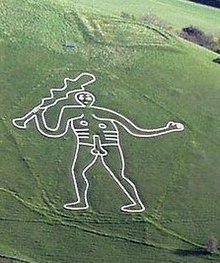


A hill figure is a large visual representation created by cutting into a steep hillside and revealing the underlying geology. It is a type of geoglyph usually designed to be seen from afar rather than above. In some cases trenches are dug and rubble made from material brighter than the natural bedrock is placed into them. The new material is often chalk, a soft and white form of limestone, leading to the alternative name of chalk figure for this form of art.[citation needed]
Hill figures cut in grass are a phenomenon especially seen in England, where examples include the Cerne Abbas Giant, the Uffington White Horse, and the Long Man of Wilmington, as well as the "lost" carvings at Cambridge, Oxford and Plymouth Hoe. From the 18th century onwards, many further ones were added. Many figures long thought to be ancient have been found to be relatively recent when subjected to modern archaeological scrutiny, at least in their current form. Only the Uffington White Horse appears to retain a prehistoric shape, while the Cerne Abbas Giant may be prehistoric, Romano-British, or Early Modern. Nevertheless, these figures, and their possible lost companions, have been iconic in the English people's conception of their past.[citation needed]
In England there are at least fifty landscape figures, the majority of which are in the south.[1]
- ^ Nigel Clarke, The Rude Man of Cerne Abbas and Other Wessex Oddities, Lyme Regis, Nigel J. Clarke Publications, ISBN 978-0-907683-07-0
© MMXXIII Rich X Search. We shall prevail. All rights reserved. Rich X Search
